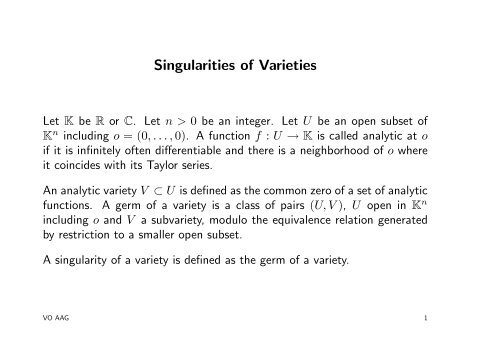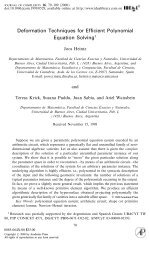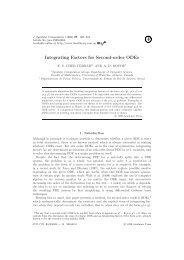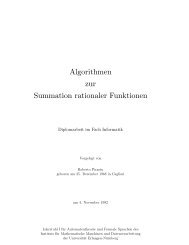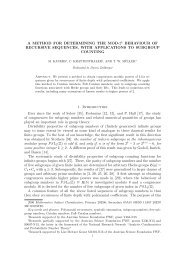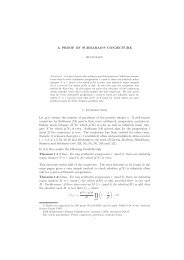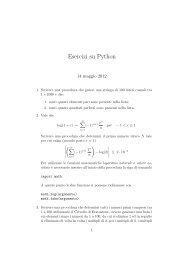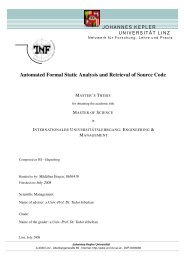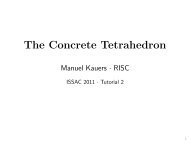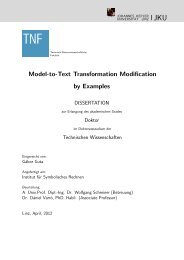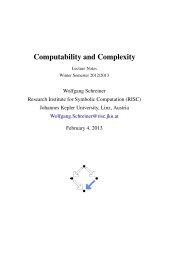Singularities of Varieties
Singularities of Varieties
Singularities of Varieties
You also want an ePaper? Increase the reach of your titles
YUMPU automatically turns print PDFs into web optimized ePapers that Google loves.
<strong>Singularities</strong> <strong>of</strong> <strong>Varieties</strong><br />
Let K be R or C. Let n > 0 be an integer. Let U be an open subset <strong>of</strong><br />
K n including o = (0, ...,0). A function f : U → K is called analytic at o<br />
if it is infinitely <strong>of</strong>ten differentiable and there is a neighborhood <strong>of</strong> o where<br />
it coincides with its Taylor series.<br />
An analytic variety V ⊂ U is defined as the common zero <strong>of</strong> a set <strong>of</strong> analytic<br />
functions. A germ <strong>of</strong> a variety is a class <strong>of</strong> pairs (U,V ), U open in K n<br />
including o and V a subvariety, modulo the equivalence relation generated<br />
by restriction to a smaller open subset.<br />
A singularity <strong>of</strong> a variety is defined as the germ <strong>of</strong> a variety.<br />
VO AAG 1
The Vanishing Ideal<br />
Let R := K[[x 1 , ...,x n ]] be the ring <strong>of</strong> convergent power series. Let<br />
V ⊆ U ⊆ K n be a singularity. Then Ideal(V ) is defined as the ideal <strong>of</strong> all<br />
f ∈ R that vanish at all points in V . It does not depend on the choice <strong>of</strong><br />
the representative.<br />
Any ideal <strong>of</strong> R is finitely generated. Vanishing ideals are radical. The<br />
converse holds for the case K = C, but not for the case K = R.<br />
VO AAG 2
Analytic Equivalence<br />
An analytic map from a variety X to a variety Y is a function f : X → Y<br />
whose coordinates are analytic functions. Two varieties are analytically<br />
equivalent iff there are analytic maps f : X → Y and g : Y → X such that<br />
fg = id Y and gf = id X .<br />
Two singularities are analytically equivalent iff there exists an analytic<br />
isomorphism between representatives taking o to o.<br />
Two singularities V 1 and V 2 are analytically equivalent iff their quotient<br />
algebras R 1 /Ideal(V 1 ) and R 2 /Ideal(V 2 ) are isomorphic as K-algebras.<br />
VO AAG 3
Automorphisms <strong>of</strong> (K,0)<br />
A convergent power series P ∈ K[[x]], P = P 0 + P 1 x + P 2 x 2 + P 3 x 3 + . ..<br />
defines an automorphism <strong>of</strong> (K,0) iff P 0 = 0 and P 1 ≠ 0.<br />
For any power series Q ∈ K[[x]] <strong>of</strong> positive order m, Q = Q m x m +<br />
Q m+1 x m+1 +· · ·+, there is an automorphism P such that Q(P(x)) = ±x m .<br />
In case K = C, we may omit the sign.<br />
VO AAG 4
Smooth singularities<br />
A variety <strong>of</strong> dimension n is called smooth or nonsingular at some point p iff<br />
its germ at p is isomorphic to the germ <strong>of</strong> K n .<br />
The Jacobian ideal is defined as the ideal generated by all (N − n)-minors<br />
<strong>of</strong> the Jacobi matrix <strong>of</strong> a set <strong>of</strong> equations generating the vanishing ideal.<br />
(N is the number <strong>of</strong> variable, n the dimension.)<br />
Theorem. A variety is smooth at a point p iff p does not belong to the<br />
zero set <strong>of</strong> the Jacobian ideal.<br />
VO AAG 5
Reducible <strong>Singularities</strong><br />
An irreducible singularity is one which is not a union <strong>of</strong> two strictly smaller<br />
singularities.<br />
Example: The zero set <strong>of</strong> y 2 − x 2 − x 3 at the origin is the union <strong>of</strong> two<br />
smooth analytic curve germs, namely the zero set <strong>of</strong> y + x + 1 2 x2 − 1 8 x3 +<br />
1<br />
16 x4 − 5<br />
128 x5 . .. and the zero set <strong>of</strong> y − x − 1 2 x2 + 1 8 x3 − 1 16 x4 + 5<br />
128 x5 ... .<br />
VO AAG 6
Plane Curve <strong>Singularities</strong><br />
A plane curve singularity is given by a squarefree power series F(x,y)<br />
vanishing at o. The order <strong>of</strong> F is invariant under analytic isomorphisms.<br />
The singularity is smooth iff ord(F) = 1.<br />
If a plane curve singularity is reducible, then its order is equal to the sum <strong>of</strong><br />
orders <strong>of</strong> the components.<br />
VO AAG 7
Weierstraß Preparation<br />
Theorem. Any plane curve singularity <strong>of</strong> order n is isomorphic to one<br />
defined by an equation F ∈ K[[x]][y] (i.e. F is polynomial in y) such that<br />
deg y (F) = n and coeff y n(F) = 1.<br />
Sketch <strong>of</strong> Pro<strong>of</strong>. First, we apply an isomorphism to transform the equation<br />
F 0 <strong>of</strong> order n to another equation F 1 which is regular in y. This means<br />
that if we write F 1 as power series in y with coefficients in K[[x]], then the<br />
constant term <strong>of</strong> coeff y n(F 1 ) is not zero. This can be achieved by a linear<br />
map (x, y) ↦→ (x + αy, y) for suitable α ∈ K.<br />
Second, we write y n as F 1 Q + R with Q ∈ K[[x,y]] and R ∈ K[[x]][y],<br />
deg y (R) < n, using power series division. Then y n − R and F 1 generate<br />
the same ideal in K[[x,y]], hence y n − R is an equation as required.<br />
VO AAG 8
Exercise<br />
Prove that every double point is analytically equivalent to y 2 − x n for some<br />
n ≥ 2.<br />
VO AAG 9
Classification <strong>of</strong> Plane Double Points<br />
How can we prove that y 2 − x n and y 2 − x m are not equivalent, for<br />
2 ≤ m < n?<br />
VO AAG 10
Generalizations<br />
A hypersurface singularity in K d is given by a squarefree power series in<br />
K[[x 1 ,...,x d ]].<br />
A hypersurface singularity is smooth iff its order is 1.<br />
The order <strong>of</strong> a reducible hypersurface singularity is equal to the sum <strong>of</strong> the<br />
orders <strong>of</strong> the components.<br />
Any hypesurface singularity <strong>of</strong> order n is isomorphic to one defined by<br />
an equation F ∈ K[[x 1 , ...,x d−1 ]][x d ] such that that deg xd<br />
(F) = n and<br />
coeff xd n(F) = 1.<br />
VO AAG 11
Generalizations<br />
The Hessian <strong>of</strong> F is the symmetric d × d matrix <strong>of</strong> all second derivatives.<br />
The rank <strong>of</strong> the Hessian and, in the real case, the absolute value <strong>of</strong><br />
the index (number <strong>of</strong> positive minus number <strong>of</strong> negative eigenvalues) are<br />
analytic invariants.<br />
Let F be the equation <strong>of</strong> a hypersurface singularity in K d such that the rank<br />
<strong>of</strong> the Hessian is equal to r and the number <strong>of</strong> positive eigenvalues is s ≤ r/2<br />
(without loss <strong>of</strong> generality, otherwise we multiply the equation by −1). Then<br />
F is analytically equivalent to x 2 1 + · · · + x 2 s − x 2 s+1 − x 2 r + G(x r+1 , ...,x d )<br />
for some G ∈ K[[x r+1 ,...,x d ]].<br />
This decomposition is unique in the sense that r and s and the analytic<br />
equivalence class <strong>of</strong> G as a singularity in K d−r are uniquely determined.<br />
VO AAG 12
Deciding Equivalence<br />
Given two squarefree power series F and F 1 , how can we decide whether<br />
the singularities <strong>of</strong> F and F 1 are equivalent?<br />
We will show that this can be decided by an algorithm who looks only at<br />
finitely many coefficients <strong>of</strong> F and F 1 .<br />
It follows that every plane curve singularity can be represented by a<br />
polynomial.<br />
VO AAG 13
Tougeron Theory<br />
Let F, G be two power series <strong>of</strong> order at least 3. We say “G is close to F”<br />
iff G − F is in J(F) 2 , the square <strong>of</strong> the Jacobian ideal.<br />
Lemma. If G is close to F, then J(F) = J(G).<br />
It follows that “close to” is an equivalence relation.<br />
VO AAG 14
Tougerons Theorem<br />
Theorem. If G is close to F, then G and F are analytically equivalent.<br />
Pro<strong>of</strong>. Given G close to F, we define an analytic isomorphism U :<br />
(x, y) ↦→ (x + S(x,y), y + T(x,y)) such that F is close to F ◦ U and<br />
ord(F ◦ U − G) > ord(F − G). Then we show that the composition <strong>of</strong><br />
these isomorphisms converges.<br />
VO AAG 15
Finite Determinacy<br />
Theorem. There exists an integer n, depending on F, such that J(F) 2<br />
contains all power series <strong>of</strong> order greater than n.<br />
Pro<strong>of</strong>. Assume, indirectly, that ∂ x F and ∂ y F have a common irreducible<br />
factor G. Then F is constant in the zero set <strong>of</strong> G, hence G divides F,<br />
F = GH for some H, and G divides G x H, hence F is not squarefree.<br />
This shows that the zero set <strong>of</strong> J(F) is just the point o. By Hilberts<br />
Nullstellensatz, the radical <strong>of</strong> J(F) is equal to 〈x, y〉. Hence there exists<br />
m such that x m ∈ J(F) and y m ∈ J(F). It follows that any monomial <strong>of</strong><br />
order at least n = 3m − 1 is in J(F) 2 .<br />
VO AAG 16
Exercise<br />
Determine N such that x 3 + y 3 is equivalent to x 3 + y 3 + G(x, y) for any<br />
G <strong>of</strong> order greater than n.<br />
VO AAG 17
Deformations<br />
A deformation <strong>of</strong> a plane curve singularity F(x, y) is a germ <strong>of</strong> an analytic<br />
function G(x, y, ǫ) such that G(x, y, 0) = F(x,y).<br />
Theorem. The order <strong>of</strong> a singularity does not increase in a deformation.<br />
Problem. Which isomorphism classes arise in a deformation <strong>of</strong> a fixed<br />
singularity? Solve this problem for F(x,y) = y 2 − x n .<br />
VO AAG 18
Group Actions<br />
A Lie group is a nonsingular variety (manifold) such that the multiplication<br />
and the inverse are analytic functions.<br />
An (left) action <strong>of</strong> a Lie group G on a manifold M is an analytic function<br />
G × M → M, (g,m) ↦→ g.m, such that (gh).m = g.(h.m).<br />
The group action induces an equivalence relation on M. The equivalence<br />
classes are called orbits.<br />
VO AAG 19
Group Actions<br />
Theorem. Let N ⊆ N be a submanifold. Let p ∈ N. If the tangents<br />
space <strong>of</strong> N and the image <strong>of</strong> the tangent space <strong>of</strong> G under the differential<br />
<strong>of</strong> the map G → M, g ↦→ g.p, generate the tangent space <strong>of</strong> M, then N<br />
intersects every orbit in a neighborhood <strong>of</strong> p.<br />
VO AAG 20
Application<br />
Let F(x, y) be a polynomial, and let n be an integer such that F(x,y) +<br />
G(x, y) ≡ F(x, y) for any G or order greater than n. We consider the group<br />
G 1 × G 2 , where G 1 is the group <strong>of</strong> all analytic isomorphisms truncated at<br />
order n, and G 2 is the group <strong>of</strong> all units in the power series ring, truncated<br />
at order n. The set M is the set <strong>of</strong> all power series truncated at order n,<br />
G 1 acts by substitution and G 2 by multiplication.<br />
VO AAG 21
Examples<br />
F(x, y) = x 3 + y 3 ,<br />
M = {x 3 + y 3 + a ij x i y j | 1 ≤ i + j ≤ 5,a ij ∈ K},<br />
TM = {a ij x i y j | 1 ≤ i + j ≤ 5},<br />
G 1 = {(u ij x i y j ,v ij x i y j ) | 1 ≤ i + j ≤ 5,u 10 v 01 − u 01 v 10 ≠ 0} ,<br />
TG 1 = {(u ij x i y j , v ij x i y j ) | 1 ≤ i + j ≤ 5} ,<br />
G 2 = {w ij x i y j | 0 ≤ i+j ≤ 5, w 00 ≠ 0}, TG 2 = {w ij x i y j | 0 ≤ i+j ≤ 5},<br />
(TG 1 × TG 2 ) → TM, (U,V,W) ↦→ 3x 2 U + 3y 2 V + (x 3 + y 3 )W<br />
The image <strong>of</strong> the map is the ideal generated by δ x F,δ y F,F. Any vectorspace<br />
in TM that contains representatives for all residue classes satisfies the<br />
assumption <strong>of</strong> the theorem.<br />
VO AAG 22
Problems<br />
Which isomorphism classes arise in deformations <strong>of</strong> x 3 + y 3 ?<br />
Same question for x 2 y + y 4 , x 3 + y 4 , x 3 + y 5 , x 3 + y 6 .<br />
VO AAG 23
Higher Dimensional Analogues<br />
Tougeron’s theorem is valid in any dimension.<br />
What fails to hold is finite determinacy. There exists no N such that for all<br />
F ∈ K[[x, y, z]] <strong>of</strong> order larger than N, x 2 +y 2 +F is equivalent to x 2 +y 2 .<br />
Finite determinacy does hold for isolated singularities.<br />
VO AAG 24
<strong>Singularities</strong> <strong>of</strong> Maps<br />
Let M, N be real differential manifolds (maybe with boundary). The set<br />
D(M,N) <strong>of</strong> differentiable functions admits several topologies. We can work<br />
with any topology such that the Taylor expansion at any point is continuous.<br />
Let us write D ∗ (M) for the set <strong>of</strong> all diffeomorphisms from M to itself.<br />
Then D ∗ (M) × D ∗ (N) acts on D(M, N) by (u,v).f = vfu −1 .<br />
VO AAG 25
Stable Maps<br />
A map f : M → N is stable iff its orbit under the action above is open in<br />
D(M,N). This means that any sufficiently close map is equivalent to it.<br />
Example. M = N = [−1,1]. Characterize all stable maps.<br />
In this example, the stable maps are dense, i.e. any map can be deformed<br />
to a stable map.<br />
VO AAG 26
Morse Lemma<br />
Assume N = R. Then f is stable iff the Hessian is nondegenerate at all<br />
critical points, and the function values <strong>of</strong> the critical points ar all different.<br />
Moreover, the set <strong>of</strong> stable functions is dense.<br />
VO AAG 27
Local Stability<br />
A map germ f : (R m ,0) → (R n ,0) is stable iff for any deformation g <strong>of</strong> f<br />
there is a point p in the neighborhood <strong>of</strong> 0 such that the germ <strong>of</strong> g at p is<br />
equivalent to f.<br />
If f is stable, then all germs <strong>of</strong> f are locally stable. The converse is not<br />
true (e.g. extra condition on values to be distinct).<br />
VO AAG 28
Infinitesimal Stability<br />
Let D m,n be the set <strong>of</strong> germs <strong>of</strong> differentiable functions f : (R m , 0) →<br />
(R n , 0). Let G m be the group <strong>of</strong> germs <strong>of</strong> automorphisms <strong>of</strong> (R m ,0).<br />
Obviously G m × G n acts on D m,n but this is not enough.<br />
Take f ∈ D m,n represented by a function defined on U ⊂ R m . For any<br />
x 0 ∈ U, x → (f(x + x 0 ) − f(x 0 )) is also in D m,n . For fixed U, this defines<br />
an action, and the derivative <strong>of</strong> this action at 0 does not depend on the<br />
choice <strong>of</strong> U.<br />
We say that f is infinitesimally stable iff the differential <strong>of</strong> the action above<br />
(isomorphism and translation together) is surjective.<br />
VO AAG 29
Example<br />
m = n = 1. We may assume that f(x) = x d for some d > 0. Then<br />
the image <strong>of</strong> the differential <strong>of</strong> right equivalence together with translation<br />
is the ideal generated by f ′ (x), which is the vectorspace generated by x a ,<br />
a ≥ d − 1. The ideal generated by left equivalence is the vectorspace<br />
generated by x b , d | b.<br />
It follows that x d is stable iff d = 1 or d = 2.<br />
VO AAG 30
Algebraic Criterion<br />
f ∈ D m,n is infinitesimally stable iff the the quotient <strong>of</strong> R[[x 1 ,...,x m ]] n<br />
by the module generated by the partial derivatives and by f i e j , where f i is<br />
the i-th coordinate <strong>of</strong> f and e j is the j-th unit vector, is generated by the<br />
unit vectors over R.<br />
Example (x, y) ↦→ (x 3 + xy, y).<br />
VO AAG 31
Whitneys Theorem<br />
Assume m = n = 2. Then f is locally stable iff f is nonsingular, or f is<br />
isomrphic to (x,y) ↦→ (x 2 ,y) (a fold), or (x, y) ↦→ (x 3 + xy, y) (a pleat).<br />
Assume dim(M) = dim(N) = 2 and M is compact. Then f is stable iff it<br />
is locally stable at any point, and the set <strong>of</strong> critical values in N is a curve<br />
with only ordinary nodes and cusps. The set <strong>of</strong> stable maps is dense.<br />
VO AAG 32
Other Cases<br />
m = 1, n = 2: locally stable iff nonsingular, stable iff image has only<br />
ordinary double points.<br />
m = 1,n > 2: stable iff immersion as a submanifold<br />
n = 1: Morse theorem.<br />
m = 2, n = 3: locally stable iff nonsingular or (x, y) ↦→ (xy, y, x 2 ). Stable<br />
iff image has local equation x = 0 or xy = 0 or xyz = 0 or x 2 − y 2 z = 0.<br />
m = n ≥ 9: stable maps are not dense!<br />
VO AAG 33
Blowing Up<br />
The blowup <strong>of</strong> the plane C 2 is an algebraic map p : Y → C 2 , where Y is a<br />
manifold that can be covered by two open subsets isomorphic to C 2 . It has<br />
the following properties:<br />
p −1 (o) is a curve E ⊂ Y. Apart from that, p restricts to an isomorphism<br />
Y − E → C 2 − {o}. The points <strong>of</strong> E correspond to tangent directions at o.<br />
Any automorphism <strong>of</strong> C 2 that fixes o lifts to an automorphism <strong>of</strong> Y<br />
preserving E. Even more, any analytic automorphism <strong>of</strong> the germ <strong>of</strong> C 2 at<br />
o lifts to a local automorphism <strong>of</strong> a neighborhood <strong>of</strong> E in Y fixing E.<br />
VO AAG 34
Total transform and proper transform<br />
If C ⊂ C 2 is a curve containing o, then p −1 (C) has two components: the<br />
proper transform ˜C and the exceptional curve E. The pullback <strong>of</strong> the<br />
equation F <strong>of</strong> C factors into x m ˜f(x, ỹ), where ˜f is the local equation <strong>of</strong><br />
˜C, x is the equation <strong>of</strong> the exceptional curve, and m is the order <strong>of</strong> C at o.<br />
The curve ˜C may have “new” singular points in E. The sum <strong>of</strong> all orders<br />
at these new points is less than or equal to m.<br />
Theorem. The procedure <strong>of</strong> blowing up singular points is finite.<br />
VO AAG 35
Invariants and blowing up<br />
The curve C is irreducible iff all proper transforms intersect E in only one<br />
point.<br />
For any plane curve singularity, the Milnor number µ is defined as the<br />
intersection multiplicity <strong>of</strong> the two partial derivatives, and the δ-invariant is<br />
defined as the height <strong>of</strong> the integral closure.<br />
Assume that P 1 ,...,P k are the singularities <strong>of</strong> the proper transform lying<br />
on E. Then the formulas hold<br />
µ = m(m − 1) + µ 1 + · · · + µ k − k + 1<br />
δ = m(m − 1)/2 + δ 1 + · · · + δ k<br />
VO AAG 36
Point Blowups in Higher Dimension<br />
The blowup <strong>of</strong> a point in C n is an algebraic map p : Y → C n , where Y is a<br />
manifold that can be covered by n open subsets isomorphic to C n . It has<br />
the following properties:<br />
p −1 (o) is a hypersurface E ⊂ Y. Apart from that, p restricts to an<br />
isomorphism Y − E → C n − {o}. The points <strong>of</strong> E correspond to tangent<br />
directions at o.<br />
VO AAG 37
Blowup <strong>of</strong> Submanifolds<br />
Let o ∈ C n . Then the blowup the submanifold L = {o} × C m ⊂ C n+m is<br />
just the direct product <strong>of</strong> the blowup <strong>of</strong> C n at o with C m . It can be covered<br />
by n open subsets isomorphic to C n × C m . The exceptional hypersurface is<br />
p −1 (L).<br />
Example: blowup x = y = 0 in C 3 .<br />
VO AAG 38
Transversality<br />
Assume H : x = 0 is an exceptional divisor in C 3 . We blow up the curve<br />
C : y = x + z 2 = 0.<br />
Step 1: Coordinate transformation making the curve into a line (x is<br />
replaced by x − z 2 ):<br />
H : x − z 2 = 0, C : y = x = 0.<br />
Step 2: First chart <strong>of</strong> blowup: x is replaced by xy.<br />
exceptional divisor becomes singular.<br />
Then the “old”<br />
VO AAG 39
Transversality<br />
Better: only blowup centers which intersect all old exceptional hypersurfaces<br />
transversally. This means: for any point, there is an analytic coordinate<br />
system such that the center is defined by coordinates AND all exceptional<br />
hypersurfaces are defined by coordinates.<br />
VO AAG 40
Variants <strong>of</strong> Resolution<br />
Resolution <strong>of</strong> varieties: sequence <strong>of</strong> blowups such that the proper transform<br />
is nonsingular.<br />
Resolution <strong>of</strong> functions: sequence <strong>of</strong> blowups such that the pullback can<br />
locally be defined by products <strong>of</strong> coordinates (monomials).<br />
Resolution <strong>of</strong> ideals: sequence <strong>of</strong> blowups such that the pullback is locally<br />
generated by such a monomial.<br />
Resolution <strong>of</strong> hypersurfaces can be reduced to resolution <strong>of</strong> functions.<br />
Resolution <strong>of</strong> varieties and resolution <strong>of</strong> functions can be reduced to<br />
resolution <strong>of</strong> ideals.<br />
VO AAG 41
Controlled Ideals, Singular Locus, Controlled Transform<br />
A controlled ideal is an ideal together with a positive integer.<br />
The singular locus <strong>of</strong> a controlled ideal (I,c) is the set <strong>of</strong> all points where<br />
the ideal has order at least c.<br />
If the center is contained in the singular locus, then the controlled transform<br />
is defined by dividing out the c-th power <strong>of</strong> the exceptional ideal.<br />
Resolution <strong>of</strong> controlled ideals: sequence <strong>of</strong> blowups with center in the<br />
singular locus, such that the singular locus is empty.<br />
VO AAG 42
Reduction Problems<br />
Can you reduce the resolution problem <strong>of</strong> ideals to the resolution problem<br />
<strong>of</strong> controlled ideals?<br />
Conversely?<br />
A controlled ideal is called tight iff its order is never greater then c. Can you<br />
reduce the resolution problem <strong>of</strong> controlled ideals to the resolution problem<br />
<strong>of</strong> tight controlled ideals?<br />
VO AAG 43
Sum <strong>of</strong> Controlled Ideals<br />
Let (I 1 ,c 1 ) and (I 2 ,c 2 ) be two controlled ideals. Then the sum is defined<br />
as (I 3 , c 1 c 2 ), where I 3 = I c 2<br />
1 · Ic 1<br />
2 . This operation is commutative and<br />
associative.<br />
Proposition. The singular set <strong>of</strong> the sum is equal to the intersection. Sum<br />
commutes with controlled transform.<br />
VO AAG 44
Rees Algebras<br />
Let R be the function ring <strong>of</strong> an algebraic or analytic variety (for instance,<br />
R = C[x 1 , ...,x n ]). A Rees algebra over R is a graded ring A = ⊕ ∞ i=0 A i,<br />
such that R = A 0 ⊇ A 1 ⊇ A 2 ⊇ . ...<br />
The Rees algebra is finitely generated iff there exists b such that A is<br />
generated by all elements <strong>of</strong> degree at most b.<br />
The singular set <strong>of</strong> a Rees algebra is the set <strong>of</strong> all points where A i has order<br />
at least i.<br />
Consider a blowup at a center in the singular locus. Then the proper<br />
transform <strong>of</strong> the Rees algebra is defined as the Rees algebra generated by<br />
the controlled transforms <strong>of</strong> (A i ,i) in degree i.<br />
VO AAG 45
Translation Controlled Ideals - Rees Algebras<br />
Let (I,c) be a controlled ideal. Then the Rees algebra A(I,C) is defined<br />
as the one generated by I in degree c.<br />
Conversely, let A be a Rees algebra which is generated in degree at most b.<br />
Then the associated controlled ideal is defined as the sum <strong>of</strong> the controlled<br />
ideals (A i ,i), i = 1,...,b.<br />
VO AAG 46


